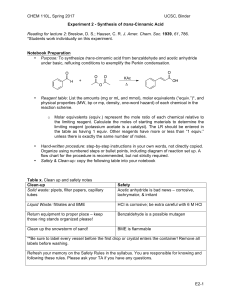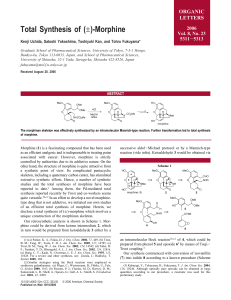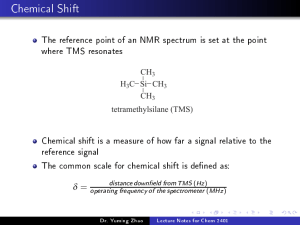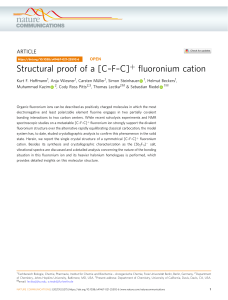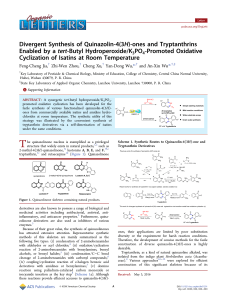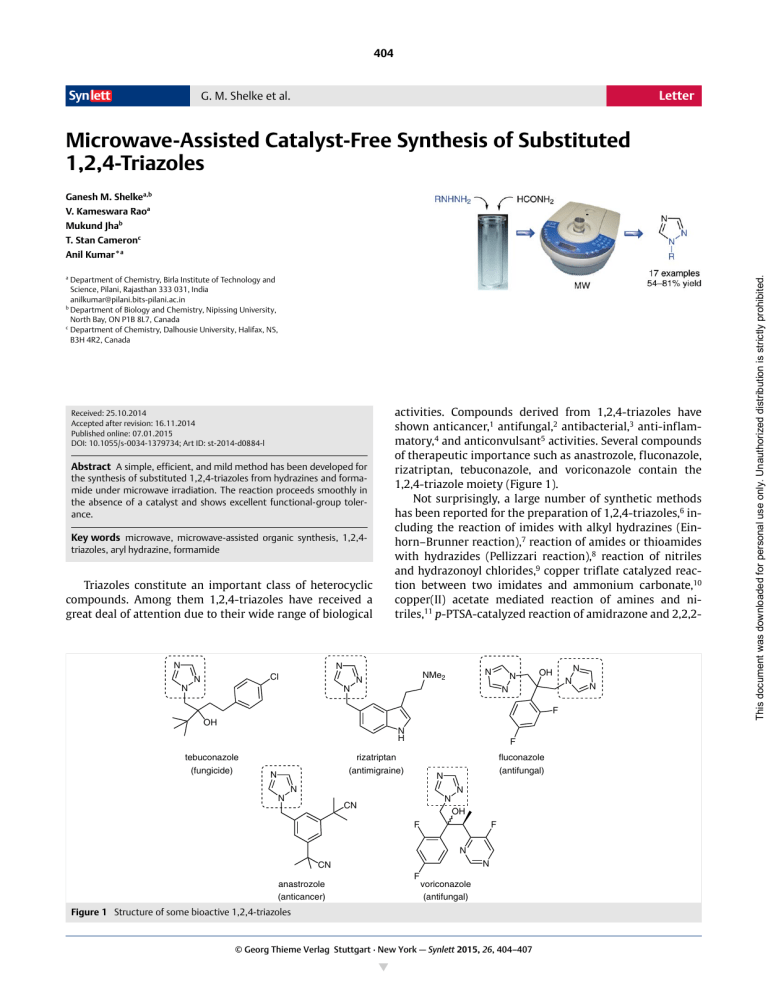
SYNLETT0936-52141437-2096 © Georg Thieme Verlag Stuttgart · New York 2015, 26, 404–407 letter Syn lett 404 Letter G. M. Shelke et al. Microwave-Assisted Catalyst-Free Synthesis of Substituted 1,2,4-Triazoles Ganesh M. Shelkea,b V. Kameswara Raoa Mukund Jhab T. Stan Cameronc a Department of Chemistry, Birla Institute of Technology and Science, Pilani, Rajasthan 333 031, India anilkumar@pilani.bits-pilani.ac.in b Department of Biology and Chemistry, Nipissing University, North Bay, ON P1B 8L7, Canada c Department of Chemistry, Dalhousie University, Halifax, NS, B3H 4R2, Canada Received: 25.10.2014 Accepted after revision: 16.11.2014 Published online: 07.01.2015 DOI: 10.1055/s-0034-1379734; Art ID: st-2014-d0884-l Abstract A simple, efficient, and mild method has been developed for the synthesis of substituted 1,2,4-triazoles from hydrazines and formamide under microwave irradiation. The reaction proceeds smoothly in the absence of a catalyst and shows excellent functional-group tolerance. Key words microwave, microwave-assisted organic synthesis, 1,2,4triazoles, aryl hydrazine, formamide Triazoles constitute an important class of heterocyclic compounds. Among them 1,2,4-triazoles have received a great deal of attention due to their wide range of biological N activities. Compounds derived from 1,2,4-triazoles have shown anticancer,1 antifungal,2 antibacterial,3 anti-inflammatory,4 and anticonvulsant5 activities. Several compounds of therapeutic importance such as anastrozole, fluconazole, rizatriptan, tebuconazole, and voriconazole contain the 1,2,4-triazole moiety (Figure 1). Not surprisingly, a large number of synthetic methods has been reported for the preparation of 1,2,4-triazoles,6 including the reaction of imides with alkyl hydrazines (Einhorn–Brunner reaction),7 reaction of amides or thioamides with hydrazides (Pellizzari reaction),8 reaction of nitriles and hydrazonoyl chlorides,9 copper triflate catalyzed reaction between two imidates and ammonium carbonate,10 copper(II) acetate mediated reaction of amines and nitriles,11 p-PTSA-catalyzed reaction of amidrazone and 2,2,2- N Cl N N N NMe2 N N N N OH N N F OH N H tebuconazole (fungicide) F rizatriptan fluconazole (antimigraine) N (antifungal) N N N N N CN OH F F N N CN anastrozole (anticancer) F voriconazole (antifungal) Figure 1 Structure of some bioactive 1,2,4-triazoles © Georg Thieme Verlag Stuttgart · New York — Synlett 2015, 26, 404–407 N This document was downloaded for personal use only. Unauthorized distribution is strictly prohibited. Anil Kumar*a 405 Letter G. M. Shelke et al. trichloroethyl imidate,12 reaction between N-acylated amide derivative with hydrazine hydrochlorides in pyridine,13 base-catalyzed reaction between nitriles and hydrazides,14 and N-arylation of 1H-1,2,4-triazole.15 However, these methods frequently require elevated temperatures with long reaction time and result in low yields, require expensive reagents, or involve multistep processes. Microwave-assisted organic synthesis provides an alternative to conventional heating and can lead to significant reduction in reaction time, minimal side reactions, and improved yields.16 Herein, we report an efficient, straightforward, catalyst-free, one-pot synthesis of 1,2,4-triazoles assisted by microwave irradiation (Scheme 1). O R NHNH2 1a–q N H NH2 2 250 psi, 230 W 10 min Table 1 Optimization of Reaction Conditions Entry Formamide (equiv) Temp (°C) Time (min) Yield (%)a 1 2.0 140 10 20 2 2.0 140 30 28 3 2.0 160 10 24 N 4 10.0 160 10 52 R 3a–q 5 15.0 160 10 63 6 20.0 160 10 74 7 25.0 160 10 71 20.0 140 10 69 160 °C, MW + N′-phenylacetohydrazide (5a) and N′-phenylbenzohydrazide (5b) were obtained in 54% and 61% yields, respectively, instead of the desired triazoles (Scheme 2). The structure of product 5 was assigned based on IR and NMR analysis and comparison with the literature.19 Furthermore, reaction of 1a with N,N-dimethylformamide did not occur and starting materials were recovered under these conditions. N Scheme 1 Microwave-assisted synthesis of 1,2,4-triazoles 8 Optimization of reaction conditions was carried out by irradiating a mixture of phenylhydrazine (1a) with two equivalents of formamide (2) under solvent-free conditions at 140 °C without catalyst (Table 1, entry 1). Under these conditions 1-phenyl-1H-1,2,4-triazole (3a) was indeed obtained but in only 20% yield. The yield of 3a was not markedly improved by either increasing the reaction time to 30 minutes or increasing the reaction temperature to 160 °C (Table 1, entries 2 and 3). However, a significant improvement in the yield was observed by increasing the amount of formamide to ten equivalents and the temperature to 160 °C (Table 1, entry 4). The best yield of 3a was observed on irradiating 1a with 20 equivalents of formamide at 160 °C for 10 minutes (Table 1, entry 6). The increase in the yield with increasing amount of formamide is in agreement with earlier reports.17 To explore the generality and substrate scope of the method, various hydrazines were allowed to react with formamide under the optimized reaction conditions. As shown in Table 2, we were able to obtain diverse 1,2,4-triazoles 3a–q using various substituted hydrazines 1a–q in moderate to good yields (54–81%). Aryl hydrazines possessing both electron-donating and electron-withdrawing substituents on the aromatic ring reacted smoothly with formamide to give corresponding triazoles (Table 2, entries 1– 15). Similarly, aliphatic hydrazines, such as tert-butylhydrazine and cyclohexylhydrazine, also gave the corresponding triazoles 3p and 3q, respectively, in good yields (Table 2, entries 16 and 17). Next, phenylhydrazine was allowed to react with acetamide (4a) and benzamide (4b) under the optimized reaction conditions. In these cases, transamidation18 products a Isolated yield of 1-phenyl-1H-1,2,4-triazole (3a). Table 2 Substrate Scope for the Synthesis of 1,2,4-Triazoles Using Microwave Irradiationa,20 R Product Yield (%)b 1 Ph 3a 74c –d 2 4-MeOC6H4 3b 76 88–89 3 2-MeC6H4 3c 75 –d 4 3-MeC6H4 3d 78 –d 5 3,4-Me2C6H3 3e 70 51–52 6 4-t-BuC6H4 3f 68 –d 7 3-FC6H4 3g 66 72–74 8 2-ClC6H4 3h 81 69–70 Entry Mp (°C) 9 3-ClC6H4 3i 78 94–96 10 4-ClC6H4 3j 76 130–132 11 2,4-Cl2C6H3 3k 68 168–170 12 3,4-Cl2C6H3 3l 79 138–140 13 3-Cl-4-MeC6H3 3m 66 128–129 14 4-BrC6H4 3n 77 146–148 15 4-NCC6H4 3o 64 162–164 16 t-Bu 3p 60e 3q e 17 C6H10 a 54 –d 66–68 Reaction conditions: 1 (1.0 mmol) and 2 (20 mmol), 160 °C, 10 min. b Isolated yield after column chromatography. c Used the free form of phenylhydrazine. d Liquid. e Reaction temperature: 180 °C. © Georg Thieme Verlag Stuttgart · New York — Synlett 2015, 26, 404–407 This document was downloaded for personal use only. Unauthorized distribution is strictly prohibited. Syn lett 406 Letter G. M. Shelke et al. References and Notes O NHNH2 + 160 °C, MW R 1a NHNHCOR NH2 250 psi, 230 W 10 min 4a,b 5a R = Me, 54% 5b R = Ph, 61% Scheme 2 Reaction of phenyl hydrazine with acetamide and benzamide Based on the experimental observations and literature reports, the probable pathway for the reaction is shown in Scheme 3. It is believed that initially transamidation of aryl/alkyl hydrazine 1 results in the formation of formohydrazide 6 that, upon condensation with formamide 2, gives 1,2,4-triazole 3. The presence of a peak at m/z = 192.96 corresponding to molecular formula C11H17N2O+ ion in the ESIMS of the reaction mixture of 1f (R = 4-t-BuC6H4) with formamide along with a molecular ion peak at m/z = 201.96 was an indication of the formation of formohydrazide 6 (R = 4-t-BuC6H4) as an intermediate. R NHNH2 MW 1 irradiation + HCONH2 2 R O HCONH2 2 H MW irradiation NHNH 6 N N N R 3 Scheme 3 Probable reaction pathway In summary, we have developed a simple, efficient, and mild method for the synthesis of substituted 1,2,4-triazoles from substituted hydrazines and formamide under microwave irradiation. The reactions proceed smoothly in the absence of a catalyst and have excellent functional-group tolerance. Short reaction times, excellent yields, and catalystfree conditions are salient features of this method. Reaction of phenyl hydrazine with acetamide and benzamide under these conditions resulted in the formation of N′-phenylacetohydrazide and N′-phenylbenzohydrazide, respectively. Acknowledgment The authors gratefully acknowledge the financial support provided by DST-FIST (CSI-174/2008) for purchase of a focused microwave and FTIR and the Natural Sciences and Engineering Research Council of Canada (NSERC) to conduct this research. G.S. is thankful to CSIR, New Delhi for a Senior Research Fellowship. Supporting Information Supporting information for this article is available online at http://dx.doi.org/10.1055/s-0034-1379734. SuponritIgfmanSuponritIgfman (1) Shivarama, H. B.; Veerendra, B.; Shivananda, M. K.; Poojary, B. Eur. J. Med. Chem. 2003, 38, 759. (2) Murabayashi, A.; Masuko, M.; Niikawa, M.; Shirane, N.; Furuta, T.; Hayashi, Y.; Makisumi, Y. J. Pestic. Sci. 1991, 16, 419. (3) Malbec, F.; Milcent, R.; Vicart, P.; Bure, A. M. J. Heterocycl. Chem. 1984, 21, 1769. (4) (a) Wade, P. C.; Vogt, B. R.; Kissick, T. P.; Simpkins, L. M.; Palmer, D. M.; Millonig, R. C. J. Med. Chem. 1982, 25, 331. (b) Hosur, M.; Talwar, M.; Bennur, R.; Benur, S.; Patil, P.; Sambrekar, S. Ind. J. Pharm. Sci. 1993, 55, 86. (5) Chen, J.; Sun, X.-Y.; Chai, K.-Y.; Lee, J.-S.; Song, M.-S.; Quan, Z.-S. Bioorg. Med. Chem. 2007, 15, 6775. (6) (a) Holm, S. C.; Straub, B. F. Org. Prep. Proced. Int. 2011, 43, 319. (b) Moulin, A.; Bibian, M.; Blayo, A.-L.; El Habnouni, S.; Martinez, J.; Fehrentz, J.-A. Chem. Rev. 2010, 110, 1809. (c) Potts, K. T. Chem. Rev. 1961, 61, 87. (d) Al-Masoudi, I. A.; Al-Soud, Y. A.; Al-Salihi, N. J.; Al-Masoudi, N. A. Chem. Heterocycl. Compd. 2006, 42, 1377. (7) (a) Brunner, K. Monatsh. Chem. 1915, 36, 509. (b) Atkinson, M. R.; Polya, J. B. J. Chem. Soc. 1954, 141. (8) Pellizzari, G. Gazz. Chim. Ital. 1911, 41, 20. (9) Wang, L.-Y.; Tsai, H. J.; Lin, H.-Y.; Kaneko, K.; Cheng, F.-Y.; Shih, H.-S.; Wong, F. F.; Huang, J.-J. RSC Adv. 2014, 4, 14215. (10) Sudheendran, K.; Schmidt, D.; Frey, W.; Conrad, J.; Beifuss, U. Tetrahedron 2014, 70, 1635. (11) Kuang, J.; Chen, B.; Ma, S. Org. Chem. Front. 2014, 1, 186. (12) Mangarao, N.; Mahaboob, B. G.; Ramu, T.; Srinuvasarao, R.; Prasanthi, S.; Siddaiah, V. Tetrahedron Lett. 2014, 55, 177. (13) Lee, J.; Hong, M.; Jung, Y.; Cho, E. J.; Rhee, H. Tetrahedron 2012, 68, 2045. (14) Yeung, K.-S.; Farkas, M. E.; Kadow, J. F.; Meanwell, N. A. Tetrahedron Lett. 2005, 46, 3429. (15) (a) Sanjeeva, R. K.; Wu, T.-S. Tetrahedron 2012, 68, 7735. (b) Antilla, J. C.; Baskin, J. M.; Barder, T. E.; Buchwald, S. L. J. Org. Chem. 2004, 69, 5578. (c) Zhu, L.; Cheng, L.; Zhang, Y.; Xie, R.; You, J. J. Org. Chem. 2007, 72, 2737. (d) Yang, K.; Qiu, Y.; Li, Z.; Wang, Z.; Jiang, S. J. Org. Chem. 2011, 76, 3151. (e) Lam, P. Y. S.; Clark, C. G.; Saubern, S.; Adams, J.; Winters, M. P.; Chan, D. M. T.; Combs, A. Tetrahedron Lett. 1998, 39, 2941. (16) (a) Lidström, P.; Tierney, J.; Wathey, B.; Westman, J. Tetrahedron 2001, 57, 9225. (b) Kappe, C. O. Angew Chem. Int. Ed. 2004, 43, 6250. (c) Polshettiwar, V.; Varma, R. S. Acc. Chem. Res. 2008, 41, 629. (d) Kappe, C. O.; Stadler, A. Microwaves in Organic and Medicinal Chemistry; Wiley-VCH: Weinheim, 2005. (17) Petree, H. E.; Pociask, J. R.; Gupton, J. T. Method for Direct Preparation for 1,2,4-Triazole from Hydrazine and Formamide, US 4267343A, 1981. (18) (a) Stephenson, N. A.; Zhu, J.; Gellman, S. H.; Stahl, S. S. J. Am. Chem. Soc. 2009, 131, 10003. (b) Lebleu, T.; Kotsuki, H.; Maddaluno, J.; Legros, J. Tetrahedron Lett. 2014, 55, 362. (c) Tamura, M.; Tonomura, T.; Shimizu, K.-I.; Satsuma, A. Green Chem. 2012, 14, 717. (d) Becerra-F, L.; Ojeda-P, A.; Gamba-S, D. J. Org. Chem. 2014, 79, 4544. (19) Ray, J. K.; Mahato, T. K.; Chinnakali, K.; Fun, H. K. Acta Crystallogr., Sect. C.: Cryst. Struct. Commun. 1997, 53, 1621. (20) Experimental Procedure for the Synthesis of 3a To a dried microwave tube was added phenylhydrazine (108 mg, 1 mmol) and formamide (0.82 mL, 20 mmol). The tube was sealed with a plastic microwave septum and then placed into © Georg Thieme Verlag Stuttgart · New York — Synlett 2015, 26, 404–407 This document was downloaded for personal use only. Unauthorized distribution is strictly prohibited. Syn lett 407 Letter G. M. Shelke et al. the microwave cavity and irradiated at 160 °C, 250 psi, and 230 W for 10 min. After completion of reaction (TLC), the mixture was cooled to r.t.; distilled H2O (10 mL) was added, and the mixture extracted with EtOAc (3 × 10 mL). The combined organic extracts were dried over Na2SO4, filtered, and concentrated under reduced pressure. The crude product was purified by silica gel column chromatography using a mixture of n-hexane and EtOAc as eluent. Spectroscopic Data for Selected Triazoles 1-o-Tolyl-1H-1,2,4-triazole (3c) Pale yellow liquid. 1H NMR (300 MHz, CDCl3): δ = 8.20 (s, 1 H), 8.05 (s, 1 H), 7.36–7.19 (m, 4 H), 2.16 (s, 3 H). 13C NMR (75 MHz, CDCl3): δ = 152.17, 143.80, 136.21, 133.90, 131.55, 129.66, 126.87, 126.06, 17.87. 1-(3-Chlorophenyl)-1H-1,2,4-triazole (3i) White solid; mp 94–96 °C. 1H NMR (300 MHz, CDCl3): δ = 8.57 (s, 1 H), 8.11 (s, 1 H), 7.74 (s, 1 H), 7.59 (d, J = 7.8 Hz, 1 H), 7.45 (t, J = 7.9 Hz, 1 H), 7.38 (d, J = 8.0 Hz, 1 H). 13C NMR (75 MHz, CDCl3): δ = 152.83, 140.91, 137.87, 135.65, 130.84, 128.26, 120.35, 117.85. 1-(3-Chloro-4-methylphenyl)-1H-1,2,4-triazole (3m) Off-white solid; mp 128–129 °C. 1H NMR (300 MHz, CDCl3): δ = 8.53 (s, 1 H), 8.09 (s, 1 H), 7.71 (d, J = 2.2 Hz, 1 H), 7.47 (dd, J = 8.2, 2.2 Hz, 1 H), 7.35 (d, J = 8.3 Hz, 1 H), 2.42 (s, 3 H). 13C NMR (75 MHz, CDCl3): δ = 152.65, 140.79, 136.24, 135.69, 135.41, 131.78, 120.70, 117.95, 19.70. 1-tert-Butyl-1H-1,2,4-triazole (3p) Brownish liquid. 1H NMR (300 MHz, CDCl3): δ = 8.16 (s, 1 H), 7.94 (s, 1 H), 1.63 (s, 9 H). 13C NMR (75 MHz, CDCl3): δ = 151.36, 139.77, 58.31, 29.41. 1-Cyclohexyl-1H-1,2,4-triazole (3q) White solid; mp 66–68 °C. 1H NMR (300 MHz, CDCl3): δ = 8.09 (s, 1 H), 7.93 (s, 1 H), 4.24–4.11 (m, 1 H), 2.22–2.15 (m, 2 H), 1.97–1.86 (m, 2 H), 1.83–1.68 (m, 3 H), 1.52–1.19 (m, 3 H). 13C NMR (75 MHz, CDCl3): δ = 151.34, 140.73, 59.37, 33.02, 25.12, 25.03. © Georg Thieme Verlag Stuttgart · New York — Synlett 2015, 26, 404–407 This document was downloaded for personal use only. Unauthorized distribution is strictly prohibited. Syn lett Copyright of Synlett is the property of Georg Thieme Verlag Stuttgart and its content may not be copied or emailed to multiple sites or posted to a listserv without the copyright holder's express written permission. However, users may print, download, or email articles for individual use.
